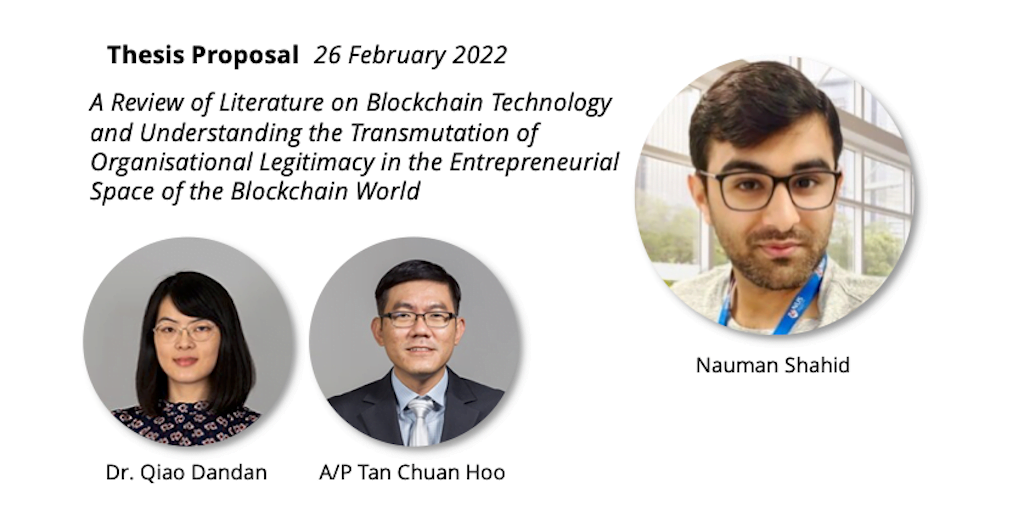
PhD Thesis Proposal — Nauman Shahid
Dissertation Title: A Review of Literature on Blockchain Technology and Understanding the Transmutation of Organisational Legitimacy in the Entrepreneurial Space of the Blockchain World
Abstract:
This dissertation contains two essays that analyse the blockchain literature and report on the transmutation of organisational legitimacy in the entrepreneurial space of the blockchain world. The first essay provides a comprehensive overview and the current state of blockchain research. Previous studies have evaluated blockchain technology (BCT) from disciplinary perspectives, focusing on its architectural or evolutionary aspects. While disciplinary perspectives influence our perception and understanding of reality in today’s world, creating new types of knowledge from the spaces between disciplinary boundaries is challenging. Some of the recent developments in design thinking, knowledge-led complexities, and the collective consciousness that underlie BCT merit interdisciplinary research. With this focus, the study aims to analyse blockchain research as a whole, explore overlooked topics, and examine research patterns and temporal trends across disciplines. Using a proven topic modelling technique, the Latent Dirichlet Allocation (LDA), the analysis of 3,644 papers signify interdisciplinarity for next-generation blockchains such as blockchain 3.0 and beyond. The results indicate dominance of solution-focused research orientation in formal and applied disciplines such as computer science and business, while classical disciplines such as law and social sciences home theory-focused research. By highlighting the disparity between the two types of research orientations, this study prompts interdisciplinary research tradition to reduce complexities of BCT ecosystems. There are three important contributions: First, the review disputes monodisciplinarity of BCT by defining it as a complex ecosystem. Second, the unveiled topics and temporal trends indicate green and grey areas of intra- and inter-disciplinarity. Third, it provides a framework for understanding BCT in relation to existing disciplines and its relevance to future science policymaking. Researchers and the general public will find this analysis of interest since it offers a way to guide emerging collaborations and interactions towards the most fruitful outcomes.
The second essay examines the current state of cultural entrepreneurship theory from the perspective of organisational-identity building. According to the organisational literature, organisational legitimacy (OL) is a source of organisational-identity building for established organisations to attract resources. Researchers have previously identified several signalling sources for OL, such as corporate social responsibility (CSR) or strategic management of public perceptions through traditional media. The purpose of using signalling sources is to differentiate the organisation from its competitors. Since traditional signalling sources are often expensive and biassed, they may prove unsuitable for early-stage entrepreneurial ventures (ESEVs). With the advent of Initial Coin Offerings (ICOs), a blockchain-based approach to ESEV financing, traditional signalling sources have become obsolete. Therefore, ESEVs use alternative methods to communicate OL, such as entrepreneurial storytelling (EST). This essay argues that EST’s optimal distinctiveness (OD) can transmit ESEVs’ OL to the resource-providing audiences (RPAs). Cultural entrepreneurship suggests that OD and OL are incompatible. This study questions the idea that OD is harmful for OL, arguing that in the case of ESEVs seeking ICO funding, it can function as a signalling source for OL. This argument is crucial because it fundamentally changes the relationship between OD and OL. Furthermore, this essay examines the role of online media as a dichotomous tool that can influence the relationship between OD and OL. A strategically managed online media can have an effect similar to traditional media, whereas online media, unlike traditional media, can shift OL, thereby limiting an organisation’s strategic monopoly. This essay examines data from 306 ICOs across 29 market categories based on the theoretical arguments above. The results confirm that OD in ICO can legitimise ESEVs and that public perceptions on the online media can influence the relationship between OD and OL.
